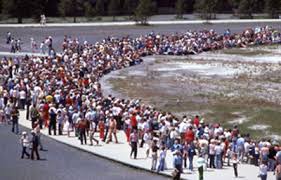Is Yellowstone the New Disneyland?

The notion that gave birth to America’s first national park in 1872, “a public park or pleasuring-ground for the benefit and enjoyment of the people,” resided then and still resides in our collective consciousness: the idea of loading up the station wagon and making a pilgrimage to commune, peacefully, in nature. But what the senator experienced was closer to the reality, and embodies one of the biggest problems in Yellowstone today: wilderness contained, nature under management, wild animals obliged to abide by human rules.
Wallop sought a way to solve the problem. He returned to Washington, D.C., and got $300,000 in federal funds so that the National Park Service could study the feasibility of erecting monorails in America’s first national park.
His bill called for the potential use of “air trains, magnetic levitation transportation” and other “environmentally cautious” ways to move people fluidly and safely through Yellowstone. “We should look at how Disney World moves vast numbers of people,” Wallop told me in 1991. “One thing Disney has been able to do that national parks haven’t is separate Americans from their cars and make them enjoy it.”
Although Wallop sometimes found himself at odds with environmentalists, his vision of an alternative to motor tourism won praise from the leaders of several conservation organizations. But Park Service planners declared the price tag—between $15 million and $25 million a mile for a monorail—too high. At the time the cost for repairs of each crumbling mile of Yellowstone’s 380-mile, two-lane highway system was one million dollars. In hindsight, the monorail may have been a bargain.
MORE>>>National Geographic
Leave a Comment Here